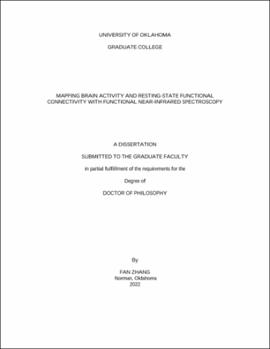| dc.description.abstract | Functional near-infrared spectroscopy (fNIRS) as a non-invasive optical imaging technique to measure cerebral hemodynamics has seen rapid development and increasing use in studying the human brain. fNIRS measures relative changes of oxygenated and deoxygenated hemoglobin in the local tissues as a surrogate measurement of neuronal activity, similarly to the blood-oxygenation-level-dependent (BOLD) functional magnetic resonance imaging (fMRI) which is the current golden standard of functional neuroimaging. Compared with fMRI, fNIRS offers competitive advantages, including low cost, portability, and compatibility with medical electronic devices implanted in patients. However, fNIRS has its limitations and faces several challenges. My dissertation aims to tackle several existing challenges in fNIRS and facilitate the achievement of fNIRS’s tremendous potential in research and clinical applications.
Firstly, fNIRS suffers from its susceptibility to superficial blood flow, cardiac pulsation, respiration, and head and jaw motions, which can lead to false positives or negatives in imaging brain activation and connectivity. Most existing fNIRS studies were based on partial montages and have not yet been fully investigated in a whole-head montage in a complex task when concurrent activations from multiple distant regions arise or in a resting-state task when coherent spontaneous activity across functionally connected areas. We have established the capability to record fNIRS signals in a cap-based, whole-head and high-density montage with short-separation channels for superficial signals and auxiliary measurements for physiological noises. I have developed a novel automatic denoising method namely PCA-GLM and demonstrated the efficacy of PCA-GLM in correcting fNIRS signals recorded during a visually guided motor task.
Secondly, the capability of using whole-head fNIRS to map the resting-state functional connectivity in large-scale brain networks, especially the default mode network which is critically implicated in the aging process and Alzheimer’s disease, has not been fully established and benchmarked to fMRI. We demonstrated the feasibility of the cap-based, whole-head and high-density fNIRS system in mapping the default mode network using conventional seed-based functional connectivity analysis. Moreover, via cross-modal comparison in the same subjects, we have for the first time demonstrated the similarity between the default mode network obtainable by a portable fNIRS system and that from fMRI, especially the medial prefrontal, midline posterior and parietal structures that are important biomarkers for normal aging.
Thirdly, the aliasing effects due to an insufficient sampling rate on functional connectivity which commonly occur in functional neuroimaging modalities, especially fMRI, are still poorly understood. Meanwhile, with the advancements in hardware and growing interest in developing high-density fNIRS with a whole-head coverage, the increases in the numbers of optical sources and detectors might come at a price of a decrease in the sampling rate. We have shown that the aliased activity due to a low sampling frequency has resulted in aliased connectivity. Furthermore, for the first time, we have discovered a network organization of such aliased functional connectivity that exists within the distribution of the default mode network, which might have confounded our understanding of the resting-state functional connectivity in the human brain.
Lastly, in addition to head motion, fNIRS is also vulnerable to jaw movements, such as clenching teeth, which can affect fNIRS measurements in the auditory, parietal and prefrontal cortices in the studies of hearing, speech and cognitive functions. While many previous studies have investigated the impact and correction of head movements, the effect and handling of jaw movements in fNIRS signals remain unclear. We have designed a novel individually customized bite bar. Our experimental work has demonstrated that the bite bar and the previously developed PCA-GLM method are effective in suppressing jaw movements, removing motion artifacts, and therefore improving auditory response and resting-state functional connectivity.
The outcomes of my dissertation have made significant advancements towards tackling the technical challenges in fNIRS. My work has paved the pathway for using fNIRS as a broadly accessible and noninvasive neuroimaging technique in many clinical applications, such as measuring auditory response in cochlear implant users, detecting abnormality of neurovascular coupling in diseased or impaired conditions, and monitoring the deterioration of the brain function in normal aging and Alzheimer’s disease. | en_US |
